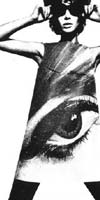
|
Paper Clothes | ||||||
| | Contents | Search | Links | Email | |
Paper Clothes were the epitome of the 'throwaway' culture of the 60's. It was an experiment with fashion. The bizarre trend originally turned up in Australia in 1967 when department stores and Mirror Newspapers presented garments modelled by Donyale Luna from 'Paraphernalia.' The outfits were stocked in several stores but not many were sold. The quality was poor and many customers were scared they would catch fire. Two years later the look came back but it never caught on. An example is the Andy Warhol inspired pop-art, paper Souper Dress. It was made of wood pulp and cotton, screen-printed with Campbell's soup tins. Another example is the series of Poster Dresses designed by the American graphic artist Harry Gordon. They were available in five different designs. One of these was a large female eye with long eyelashes. The image was screen printed onto an A-line mini dress that fastened at the left shoulder with Velcro strips. The material used for these dresses were produced like felt by a binding process with wood pulp and rayon mesh. These dresses were very fragile and light sensitive. They were made to be worn once or twice and thrown away. Paper underpants were also manufactured but they did not sell well.
Sixties Central, Copyright
1998-2003 by Mandy Hoeymakers. |
|
|||||
Related
Media
|
|||||||
 |
|||||||
